This post is long, I was thinking of splitting it, but it had so many tips, I kept it as it is. You might want to grab a cup of coffee!
Whilst I don’t often do demo lessons, I was asked to do a few when I was over in Russia, partly to counter the “this works great for adults but what about kids?” attitude from teachers, plus of course the organisers wanted to make sure Genki English works like we say it works!
And luckily enough with 3 different classes we ended up with the 3 different types of demo class.
Type 1: The “Show” Super Easy Showy Off Class
Pros: Guaranteed to be a success and create a “wow” impression
Cons: It’s a touch “artificial” & kids don’t learn anything new
Content: Disco Warm Up, What’s your name?, Superhero
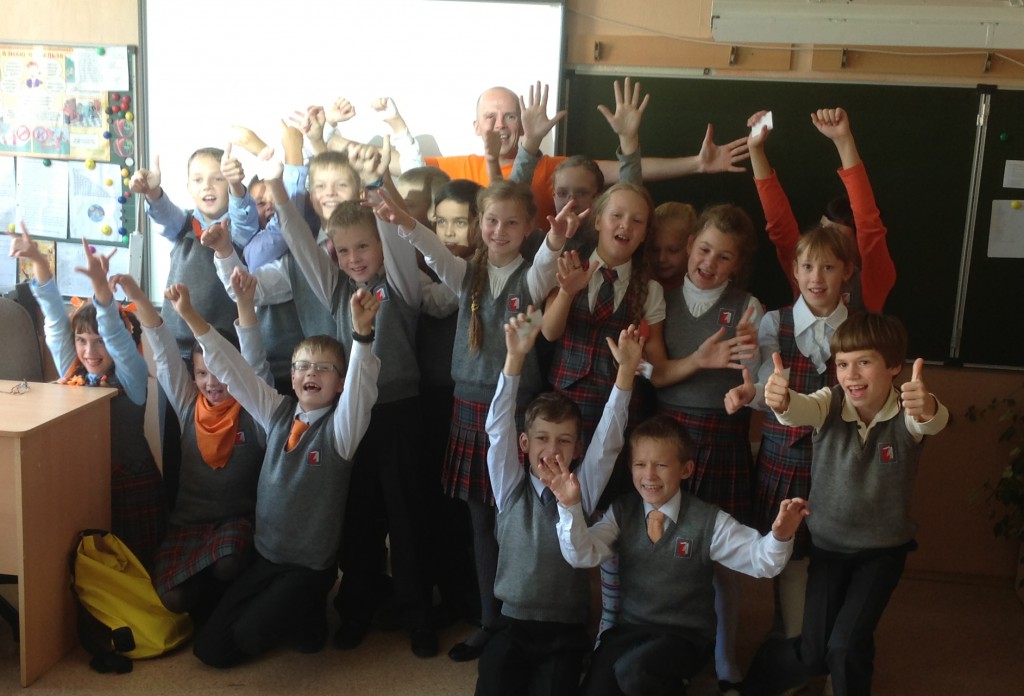
This is the content I use when you have to give a good show to impress everyone or if you’re not sure what the kids will be like.
The key is to be totally in control and get discipline from the start with the TPR Warm Up, straight into the Genki English rules (“I can do it!” & “Try again!” ) and the Disco Warm Up. This establishes a fun atmosphere, but more importantly it lets you control the class for the activities to come, you say “Stand up” and you know they are going to do it straight away!
Content wise the What’s your name? song is always a hit because the kids are all talking and excited amongst themselves, plus the Superhero song gets such a great atmosphere.
You pretty much can’t go wrong with this content, whatever the kids’ (or adults!) ages.
The main disadvantage is that you’re usually not teaching anything new, so it is more like a show than a real lesson.
Ninja Tip: Classrooms in Russia have interactive whiteboards so we got the superhero software game on there, everyone, kids and teachers, were very impressed with the use of technology – usually it’s just used for playing videos!
.
Type 2: The hybrid – pushing it a touch!
Pros: Nice balance of “guaranteed hits” & something new
Cons: Always have another backup “hit” just in case everything goes pear shaped!
Content: Disco Warm Up + something new, then keep What’s your name? or Superhero just in case you need them!
In the second class I did the Disco Warm Up to get the discipline, then the Eat! Drink! Dance! song. (The kids were different, but the teachers were the same so I wanted to show a variety of lessons.) These were 5th grade kids in Russia (i.e. very good!) so I wanted to push a little more so tried the What do you want to do? lesson. Here I put the “Words 2” flashcards on the board …
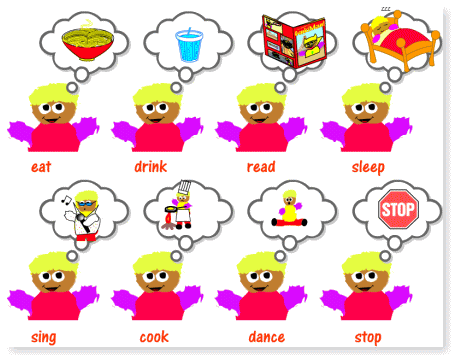
But as I pointed to the first one, instead of them just saying “I want to eat” they continued on and said “I want to …” with all of them!
So far too easy! And of course in a real class if that happens you move on, there’s no point doing activities for this type of thing if they already know it all.
So I got my interpreter to ask them “OK, what are you studying at the moment?” To which they replied, in English, “present continuous.”
Perfect! This very neatly leads into the What are you doing? song & game So I told them to “Eat!” and then asked them “What are you doing?” to which we had a load of blank faces. They understood the words “present continuous” but not the phrase “What are you doing?” 🙂
So after teaching the new phrase using the song (songs are always the best way to teach new phrases/grammar points) we did the Harry Potter game. As the language was still new you could see the class teacher beginning to move a little uncomfortably in her seat as she watched her kids give a not perfect, and often stumbling, performance. But this is why we do the games, to get practice and get better, not to rehash something they know perfectly.
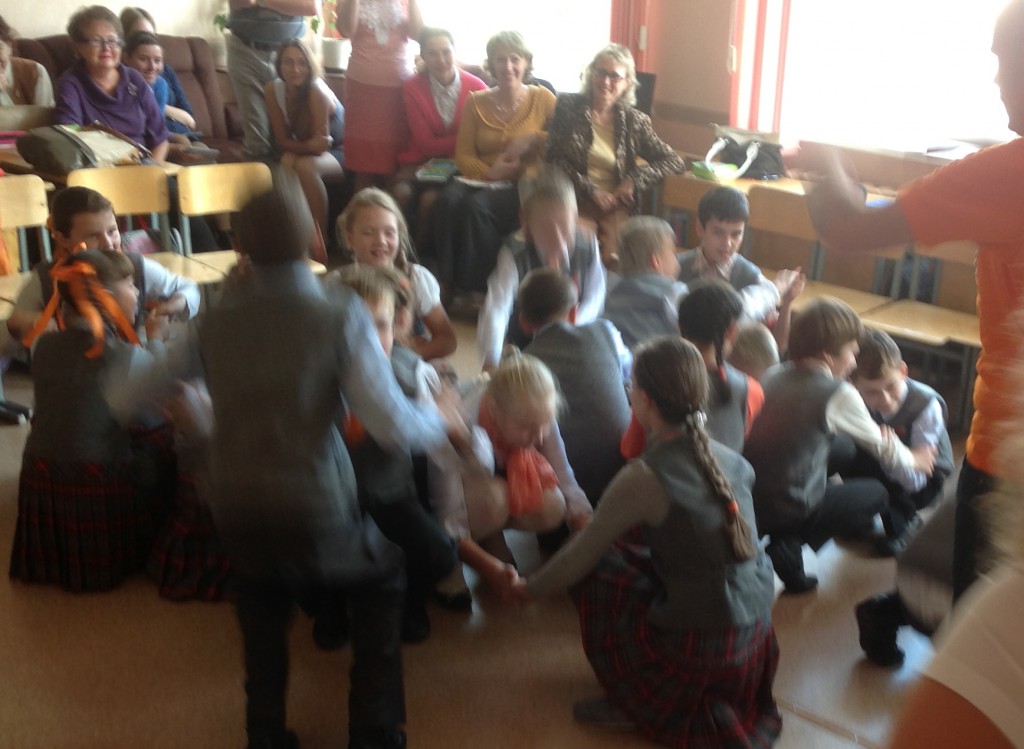
Ninja Tip: The key with any of these group games is to quickly explain it, then get into the game as soon as you can. Then shut it down after 2 or 3 minutes so you can explain any misunderstandings of rules, or more often, to re-review the new language using the “Words 2.” You can do this many times and it’s a great way to add in more repetitions of the English without losing any motivation. Plus you can also add in extra things like telling kids to shout out “help” if they are trapped, or telling everyone to work together as a team more if they are just running around and not helping anyone!
Needless to say by the end of the class they were fluent with the question and answers. Well done everyone, job done!
.
Type 3: The Brand New Lesson!
Pros: This is real!
Cons: You have to really know the kids’ level and abilities.
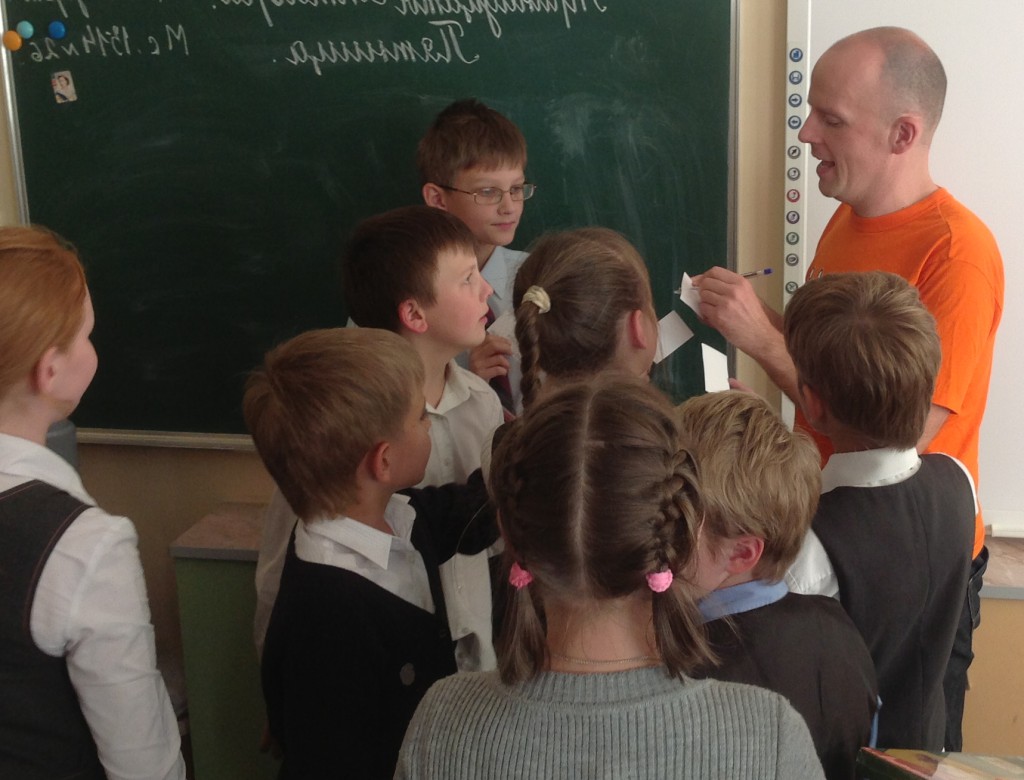
As the kids so far were so good with actually learning new material for the final school I wanted to teach something brand new that they hadn’t done before. The idea here is that you can show the materials to their full effect and how much more fun and efficient they are compared with traditional ways of teaching. The risk, of course, is that if you don’t know the kids well or they haven’t done the previous material well, it can all go pear shaped. So only do these types of “real lessons” as demo classes if you are really confident.
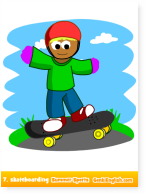 I knew these kids could do it, and I also really wanted to teach this lesson myself, so we did the What did you do in the summer? Cue looks of horror on the teacher’s face as she protested that they hadn’t done past tenses yet! No worries, that’s why we’re going to teach it!
I knew these kids could do it, and I also really wanted to teach this lesson myself, so we did the What did you do in the summer? Cue looks of horror on the teacher’s face as she protested that they hadn’t done past tenses yet! No worries, that’s why we’re going to teach it!
And it worked like magic. Start of easy with the “I like ….” plus the sports names, then a practice with the I like everything game. Easy. Then just one change of word to make sentences with “I went …” and again the I like everything game. It took a few goes of the game (failing them and saying “Can you do it faster this time?”) But by the end of the lesson they could use this form of the past tense with no problems, and in a fraction of the time it takes to teach it with the regular materials.
Needless to say the teacher was now very proud of her students and was saying she knew they could do it all along! 🙂 Bigger risks. yes, but also bigger rewards.
.
Which will you choose?
So those are your three options when you come to do demo lessons, a show, a hybrid or something new. Of course it’s up to you to choose which you want to do, and what you are trying to achieve with the demonstrations. But don’t be afraid of taking risks every now and again, even the failures teach us a lot and adrenaline is always a good thing! 🙂
I hope you liked the post and it wasn’t too long, do let me know what you think in the comments!
Plus a massive thank you to Elena for organising and pushing me to do this, and of course Julia for creating the precedent the week before!
P.S. We don’t have videos of the lessons (yet!), but here’s a quick movie of me in Red Square at the end of the trip!



Hi everyone,
I was there at those lessons. All of them were great and different . There was one moment when I started to worry. It was when children started to play Harry Potter game. It seemed like children wanted th play more than to speak English)). I saw 100% of a game and about 20 % of practising English. It looked like a real lesson not like a Demo one. I read a question on teachers faces: what are you going to do with this? I was surprised that Richard didn’t stop the children at once. He let them play. Then he said: The problem is during the game you were speaking English so quietly(he didn’t say that some of them forgot about speaking English at all)that teachers at the back of the class were not able to hear you. Can you do this again and speak louder so the teachers can hear you??? Guess what the kids said: Yes I can!!!!
It was amazing! Thank you Richard! You are always welcome to come again. Yes, we have some videos of these lessons. I will try to send them as soon as possible.
Hi Richard!
It was great to read about your impressions from Russia on your blog again, and about the types of demo lessons. It’s very important to know how to impress our students and how to give them a real food for thought. And what is nor least important to know how to maintain the excitement from the demo-lessons during the usual ones.
And it was so nice to here you speaking Russian!! 🙂
Hi Elena!
Thank you for your comment. Situations when children ‘forget’ their language aim happen very often. And here is Richard’s great hint how to deal with such ‘trouble’.
I was wondering, what do you do for a demo lesson for opening a new class at a private school? This is what I did recently for true demo classes (I even told my boss that I would NOT do a demo for a full hour or hour and a half for little tiny kids).
I start with either straight off playing the Genki Warmup Song, the kids love the tune and the dancing bears. Quick way to get them to understand “Stand Up and Sit Down”. Then I do an extended warm-up of physical commands (teaching them all these new things as they have ABSOLUTELY no English yet). So, touch your “body parts”, “actions”, etc.
Then I have to demo a little bit of how I have to actually teach much of the class based on the school’s content that I must teach. Thus, dreaded flashcards, but fun animals, so not so bad. Maybe play a listening game, sing the warmup again and then the kids are happy and not worn out after maybe 30 to 40 minutes.
My boss insists on demo classes to bring in prospective students (OK), but then when two or three sign up, he opens a class and then stipulates that we will have a SHOW class (we teach the first lesson, but the signed up kids get it for free, and then others can still watch as a demo — except now it is a 90-minute slogfest of a demo)…which begs the question, why not just have another pure demo for more prospective students.
So yesterday, I had this first class/still a demo, since most of the kids were actually not yet signed on (three students, plus six “observing”). Of course a good class is good enough to be a demo, but an 1 1/2 hour class is a struggle for 3-5 year olds, especially on their first day. How do you get the concept across to the kids of asking and answering questions? How do you get them the concept of their NAME and to fill in the blank during the song. No matter how often my TAs tell the students how to do it, the kids don’t seem to really pick up on it. Eventually the kids will be able to ask and answer What’s your name, but I have yet to have any class really successfully sing the song.
Just to confirm, you regularly teach 1 1/2 hour classes to 3-5 year olds? Wow now that is a challenge.
With kids that young I wouldn’t have the goal of production just yet. Have them wear nametags and you can help them if they get stuck. Get them in a circle, pass around the ball and play some music. When the music stops introduce yourself to that student and shake hands. Tell the others to say, ‘Hello (student’s name)’
Do other activities that involve gestures. You say the word and students do the gestures or find the card.
You can have some downtime by having them color or by reading them a book.
They need a lot of input at this age, and like you said many are not ready for output.
I think it would be more realistic to have parents seeing their student react to the language. If you have students speaking on their first day, parents will be expecting that of every class.
Just my two yen….
Yeah, my last class I started are brilliant with the questions now…of course, now they’ve been exposed to over 24 lessons of “What’s your name?” “Are you a boy/girl?” “How old are you?” etc. The first six lessons are really slow going as they are learning just how to respond to my commands, answer questions intelligently (like I said, my last class I started before this one amaze me with how they understand what I mean when I change the question even if they haven’t learned the grammar outright…for example, “What HIS name? Who is that?” Never taught them those except by just asking and eliciting answers. So my question is just how to get through those first lessons. Thanks!
Well our school (DDDragon) expects speaking right off the bat. I think most of the parents are actually just amazed and happy that their kids aren’t completely terrors during class. Anything else is bonus.
As I expected, doing an 1 1/2 show/warmup class for the first lesson got many parents concerned about the class being too long. I agree that the first lessons are insane at that length (quickly the kids adapt and we usually don’t have enough time to fit all the fun in). My boss heard the concerns and suggested I give a longer break time (15 minutes as opposed to 10.) I usually give 15 minutes for all my Kindergarten level classes anyways.
Here’s hoping I have more than three kids tomorrow for this class. More kids equal more energy and fun.
Yes, all classes are 1 1/2 hours. For the older kids I tend not to have enough time to complete all the material for each lesson (material from our curriculum). To do every task on the lesson plans at this school, each activity could only take 4 or 5 minutes.
I still don’t know how to get the kids to effectively sing the “What’s your name?” song. The concept of moving around and talking to other kids is still a difficult and foreign idea for my older kids, let alone 3-5 year olds. I’ll try it out on my Raspberry class (the little kids I started before this most recent batch). They are all solid on their names and actually talk to each other quite a bit in English.
Hi Richard,
You’re simply amazing! Your ideas are fantastic too and it seems to me that you’ve been doing a really good job in English language classrooms. Personally, I started to use some of your ideas, songs,games with 3 year-old-kids and they loved it. I’ve been working with them for 16 months now (once a week) and they’ve acquired so much knowledge that their parents can’t believe it. They are having so much fun that they don’t want to leave the class…and this is thanks to you.
THank you Richard.
You’re simply brilliant! That’s all I can say! How you got those kids to speak more by just telling them the teachers in the back didn’t hear them! Brilliant! Can’t think of another word to describe it!
I am now beginning to feel a bit more comfortable with Genki. I used parts of it last year (the free material) to get a taste of it and put it test, and this year, I put it to work in class, now that I belong to the Genki club. I’ve adapted various things, used some, didn’t use others, but what is clear, is that the kids love the stuff!
I had my kids on a review that lasted forever (mainly due to laziness) and when I went back to Genki, it was like giving the kids an energy filled injection cause they haven’t stopped since! They were soooooo happy to go back to Genki! It actually surprised me! I knew they liked it, but not that they loved it!!!!
I’ve even done a couple of 4 in 1s (body parts and family units – the kids were already familiar with that material – so I put together the 4 family units to make a 4 in 1 unit. Did the same with the body parts units.) and they were really excited with the term “4 in 1” LOL! Made them feel smarter and more hard working!! hahaha
The whole thing was sooo cool that during one of the story books that reads itself, the kids asked to read it and to shut off the recording!!!!! Now how coool is that?!
Looking forward to seeing the videos of your demo lessons! Thanks for all your great ideas and help!!!!